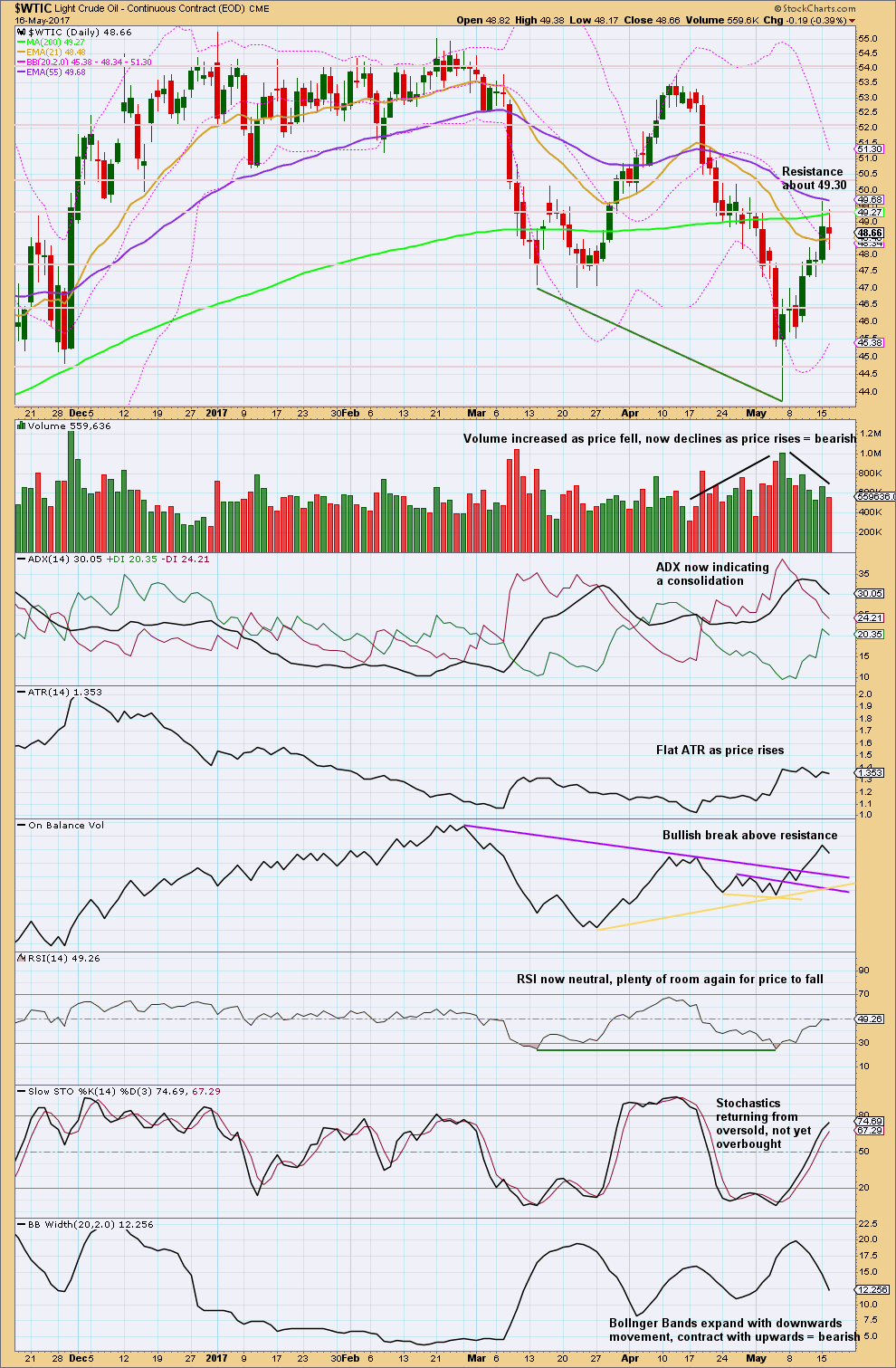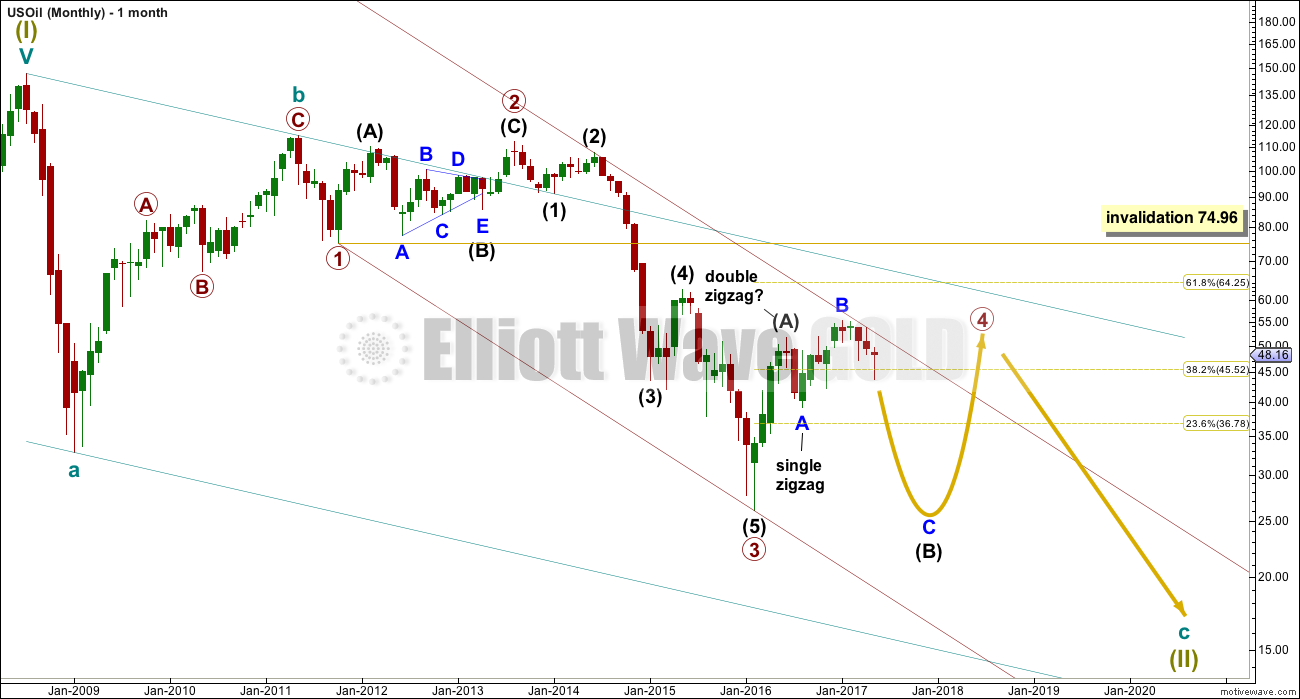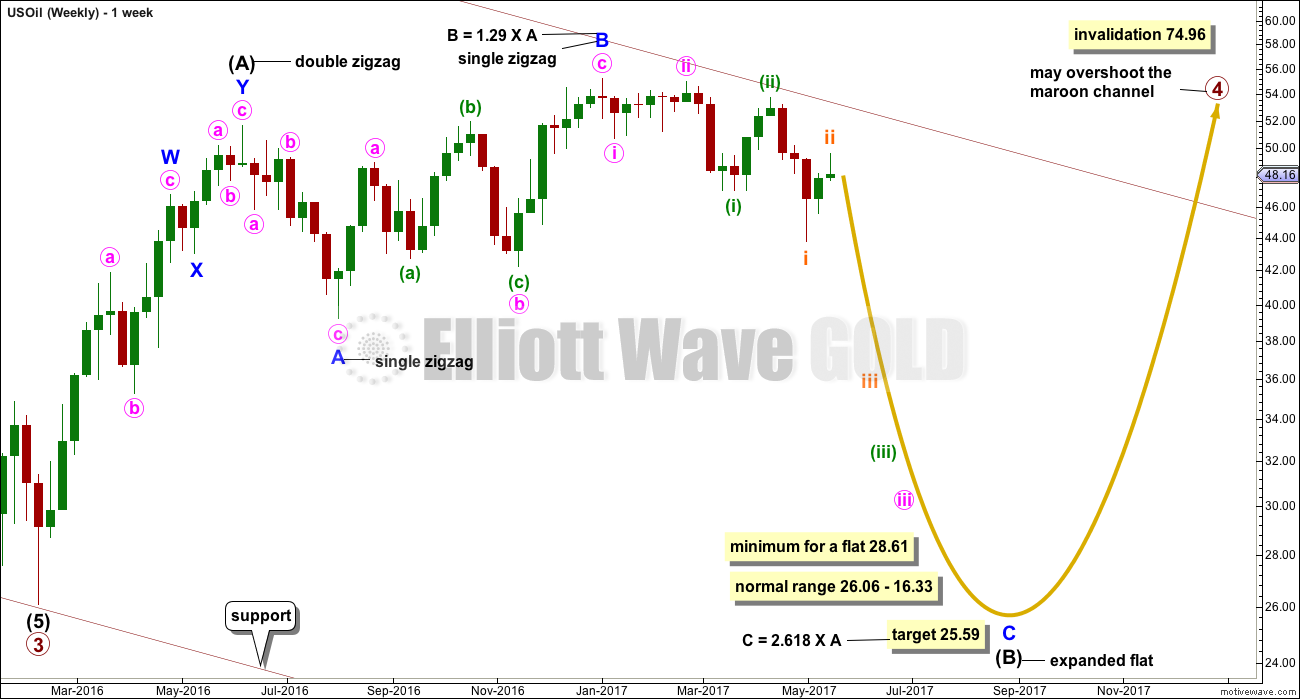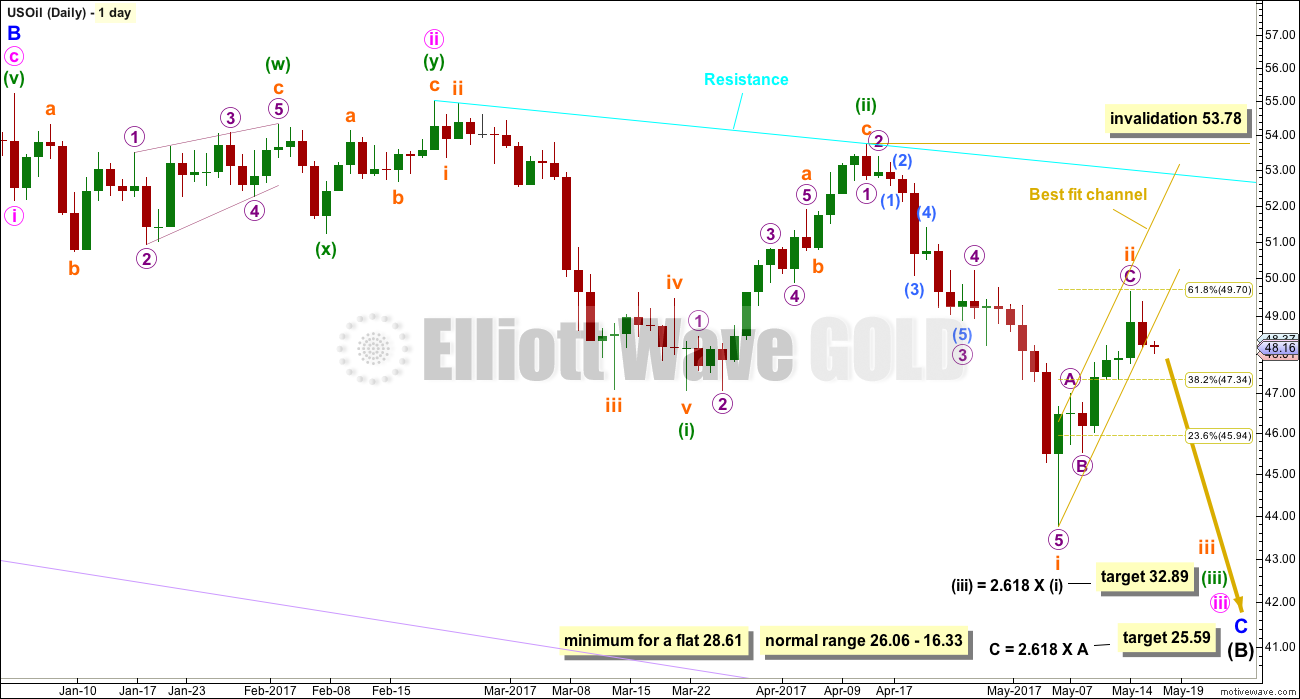The upwards bounce was deeper than expected. Profitable short positions were closed.
Summary: While it is possible that price could continue higher, it looks likely that it has stopped here. The candlestick reversal pattern (Harami), the trend channel breach, a 0.618 Fibonacci ratio, and resistance at the 200 day moving average point to an end to this bounce here.
The trend still looks to be down. This may be another good opportunity to enter short.
Always use a stop. In this case, stops should be set just above 53.78. Do not invest more than 1-5% of equity on any one trade.
New updates to this analysis are in bold.
MONTHLY ELLIOTT WAVE COUNT
Within the bear market, cycle wave b is seen as ending in May 2011. Thereafter, a five wave structure downwards for cycle wave c begins.
Within cycle wave c, at this stage it does not look like primary wave 5 could be complete. That would only be possible if primary wave 4 was over too quickly.
Primary wave 1 is a short impulse lasting five months. Primary wave 2 is a very deep 0.94 zigzag lasting 22 months. Primary wave 3 is a complete impulse with no Fibonacci ratio to primary wave 1. It lasted 30 months.
Primary wave 4 is likely to exhibit alternation with primary wave 2. Primary wave 4 is most likely to be a flat, combination or triangle. Within all of these types of structures, the first movement subdivides as a three. The least likely structure for primary wave 4 is a zigzag.
Primary wave 4 is likely to end within the price territory of the fourth wave of one lesser degree; intermediate wave (4) has its range from 42.03 to 62.58.
If primary wave 4 is incomplete, then it looks like it may not remain contained within the channel. Sometimes fourth waves overshoot channels and this is why Elliott developed a second technique to redraw the channel when it does not contain a fourth wave.
Primary wave 4 is most likely to be shallow to exhibit alternation in depth with primary wave 2. So far it has passed the 0.382 Fibonacci ratio at 45.52. It may now continue to move mostly sideways in a large range.
Primary wave 4 may not move into primary wave 1 price territory above 74.96.
At this stage, primary wave 4 has completed intermediate wave (A) only. Intermediate wave (B) is incomplete.
WEEKLY ELLIOTT WAVE COUNT
The whole structure of primary wave 4 is seen here in more detail.
The first wave labelled intermediate wave (A) is seen as a double zigzag, which is classified as a three.
Intermediate wave (B) is also a three. This means primary wave 4 is most likely unfolding as a flat correction if my analysis of intermediate wave (A) is correct. Flats are very common structures.
Intermediate wave (B) began with a zigzag downwards. This indicates it too is unfolding most likely as a flat correction.
Within intermediate wave (B), the zigzag upwards for minor wave B is a 1.29 correction of minor wave A. This indicates intermediate wave (B) may be unfolding as an expanded flat, the most common type.
The normal range for intermediate wave (B) within a flat correction for primary wave 4 is from 1 to 1.38 the length of intermediate wave (A) giving a range from 26.06 to 16.33.
Primary wave 4 may not move into primary wave 1 price territory above 74.96.
Within the larger expanded flat correction of primary wave 4, intermediate wave (B) must retrace a minimum 0.9 length of intermediate wave (A) at 28.61 or below.
DAILY ELLIOTT WAVE COUNT
Minor wave C downwards must subdivide as a five wave structure.
Minute wave iii still looks like an incomplete structure; at the last low, it does not look like an impulse.
So far now there would be three overlapping first and second waves within this wave count. This indicates a possible strong increase in downwards momentum to come as the middle of a third wave passes.
Subminuette wave ii may not move beyond the start of subminuette wave i above 53.78. Subminuette wave ii may have ended at the 0.618 Fibonacci ratio two days ago.
The target for minuette wave (iii) remains the same.
A small best fit channel is used about this upwards movement. The current daily candlestick looks like it may breach the channel, signalling an end to the bounce.
TECHNICAL ANALYSIS
DAILY CHART

Click chart to enlarge. Chart courtesy of StockCharts.com.
The last two daily candlesticks complete a Harami reversal trend. This is not a very strong reversal trend, but when coming after a bullish trend it signals a potential change.
Price may be finding some resistance here about 49.30 and the 200 day moving average.
Volume quite strongly indicates the trend is still down; it supports downwards movement and does not support upwards movement. For price to continue to rise, it needs the activity of buyers and so far that is not happening with any consistency over the last eight days.
VOLATILITY INDEX

Click chart to enlarge. Chart courtesy of StockCharts.com.
Normally, volatility should decline as price rises and volatility should increase as price falls. Divergence from this normal can provide a bullish or bearish signal for Oil. However, it is noted that this signal occurs both in minor and major lows and it cannot be used to distinguish between them.
There is no bearish divergence between the high for price one session ago and volatility; as price made a new high, volatility made a new low.
This analysis is published @ 12:47 a.m. EST.




Thanks Lara
oil long for now:
https://www.edelsoninstitute.com/geopolitical-investment-cycles/heres-whats-next-oil/?sc=WAV-E
I do not usually do hourly charts for Oil.
And Oil analysis is once a week, not daily.
Given that, and given that I have a short position on Oil, I do often update the analysis with a chart in comments during the week.
The upwards movement still has relatively light and declining volume. There is now bearish divergence with price and On Balance Volume between today’s high and the high of the 27th of February. ATR is flat. Stochastics is overbought now for 3 days.
I would be expecting this upwards trend to end sooner rather than later.
A new channel is drawn about this upwards trend. When it’s breached by downwards movement that shall be a strong indication now that the bounce is over.
If it is over here, micro C is just 0.27 short of 0.618 the length of micro A.
The bottom line: we need to see this channel breached properly before we can have confidence of a high in place.
If that happens I’ll add to my short position and hold on.
Thanks for the update
These extra updates are much appreciated. Thanks.
Hi Lara…can u give us a good snapshot of what your seeing on oil? I’ve been long for a week and would like some guidance. Thanks!
Long for a week,.. good on you. Shall we join you and go long too or are we turning south soon?
Oil back tested the breakdown of the trend line and is looking good for a drop down
I sure hope so. My shorts aren’t looking good…
Price is testing our patience! I am confident the analysis of future price action is sound and I am hanging in there… 🙂
Strangely enough, both DRIP and USO were up today!
Do you have any hourly charts with Elliott wave counts for oil
Any update on oil it’s looking pretty bullish?